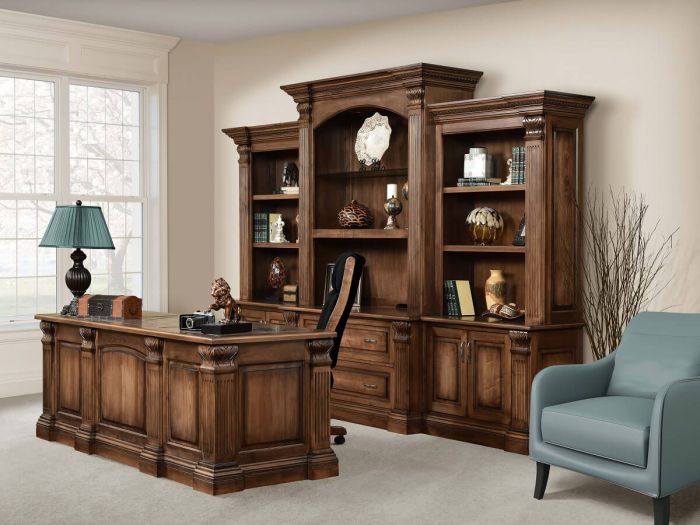Different Traditional Furniture Styles and Decorating Tips
By Bailiegh Basham · November 29, 2022
When we say the phrase “traditional style furniture,” you may picture carved flourishes, rich upholstery, and the use of heavy wood. However, when asked to actually define “traditional style furniture,” you may find yourself struggling to pinpoint a precise answer. This is because multiple furniture decor themes can fall under the broad umbrella that is traditional. Specialists trace the origins of traditional furniture design to 17th Century Europe but, as time went on, interpretations of these design choices diversified and blended with new influences.
In this article, we’ll explore different types of traditional furniture and how to incorporate this timeless decor theme into your home, today.
If you’re more interested in shopping, below are links to help you get started:
- Traditional bedroom furniture
- Traditional dining room furniture
- Traditional living room furniture
- Traditional office furniture
Firstly, What Is (and Isn’t) Traditionally Styled Furniture?
Though there are variations on traditional style, all share defining characteristics that differentiate them from other decor themes.
Traditional style furniture has:
- Visually enhanced legs with curved shapes (think cabriole legs)
- Complex table edge profiles, such as ogee styles
- Hardware is gold or brassy with intricate touches
- Textiles are much more limited with the most prominently used being solid wood
Comparatively, contemporary furniture is more likely to have:
- Minimalistic appearance - straight lines and adorned surfaces
- Basic table edges
- Hardware is silvery or black with simple shapes
- The utilization of diverse materials; wood is still popular, but other options include metal, glass, and high-quality plastics
Different Types of Traditional Furniture Styles
The below list of traditional style furniture subcategories is by no means comprehensive. However, we chose to spotlight those which are more popular today, visually distinct from one another, and are simply amongst customers.
Queen Anne Furniture
Queen Anne may not be the most well-known British monarch, but this 18th Century ruler was immensely popular during her early-18th Century reign. During her heyday, traditional furniture styles underwent a significant revolution. Impractically bulky/heavy pieces were abandoned in favor of lithe silhouettes enhanced with feminine curves. Many design enhancements we associated with Queen Anne furniture also benefit the comfort of the user, from the curved chair back to the use of luxurious upholstery. Generally speaking, cherry wood and darker stains were most used amongst this specific traditional furniture style.
For additional insights into this traditional style theme, read Queen Anne Furniture - Styling and Buying Tips.
Shaker Furniture
The seed of this particular traditional furniture style can be found in New England amongst historic Shakers (a sect of Quakerism). Believing that a simple lifestyle led to divinity, they built furniture to serve set purposes rather than to decorate. The results are highly practical, quality pieces built to last for decades (with straightforward appearances that can actually be quite beautiful).
While you can’t go wrong building Shaker style furniture with any hardwood, it is most frequently associated with maple and cherry. Additional common characteristics of Shaker furniture are tapered legs, wooden pulls, concealed joinery, and graduated drawers. However, no discussion of this traditional furniture style would be complete without mention of ladder back chairs, arguably the most popular way to feature Shaker design in the home. For more tips, check out our favorite Shaker dining furniture sets.
American Colonial Furniture
The concept of America as a melting pot doesn’t just apply to its people, but also its furniture style. This design theme blends the usefulness of Shaker styles with Queen Anne and other European-based trends (especially those based in France). For this reason, this traditional furniture style often blends wood-carved flourishes like fluted legs with simple, comfort-driven features like Windsor backs.
Arts & Crafts Furniture
The name Arts and Crafts says it all; this traditional furniture style was born during the late 19th Century amongst artisans in the repulsion of mass-produced goods. William Morris is considered one of the movement’s forefathers and is commonly associated with the William Morris chair, which continues to be popular today. He and his English peers embraced design decisions that would heavily influence Mission furniture.
When you compare Arts & Crafts pieces with some other traditionally styled furniture (like Queen Anne designs), the sharp contrast is obvious. Arts & Crafts favors simple, clean lines with minimal flourishes that don’t serve the function of the piece. While the craftsmen embraced all types of quality hardwoods, oak was particularly prevalent. Their main priority was to choose stains that emphasized the integrity and natural grain of the wood.
Tips for Decorating With Traditional Style Furniture
- Don’t feel beholden to the favored wood species and coloring of specific traditional style periods. For example, we discussed earlier that Queen Anne furniture frequently utilized cherry wood. However, if you’re custom ordering a Queen Anne style dining table, we suggest you choose the wood and stain which speaks to your personal tastes and fits with your overall decor rather than limiting yourself to the design decisions of bygone eras.
- Don’t overcrowd the traditional furniture with too many visual distractions - Whether we’re talking about detail-rich Queen Anne or streamlined Shaker pieces, traditional furniture is extremely intentional. While these subtle features can bring an effortless sophistication to the space, they can also get “lost amongst the noise” if surrounded by “louder” design choices or accessories.
- Traditional furniture doesn’t necessarily limit you to an exclusively traditional decor theme - As we explore in Tips for Updating Traditional Dining Room Decor, blending classic furniture with contemporary touches like an artistic chandelier, avant-garde centerpiece, or modern color schemes can add visual intrigue truly unique to your home.
- Invest in quality interpretations of traditional style - Though “traditional furniture” is incredibly diverse, a uniting theme is its use of genuine hardwood and handcrafted construction. Purchasing mass-produced pieces made with wood-imitations will result in a watered-down effect.
Shop for Traditional Style Pieces With Countryside Amish Furniture
Each and every piece we offer is made-to-order by Amish craftsmen using traditional techniques, resulting in solid wood masterpieces that will last the ages. We welcome you to explore our many traditionally styled furniture designs, available for each room of the house. Buy them individually or as a complete set, the choice is yours!






